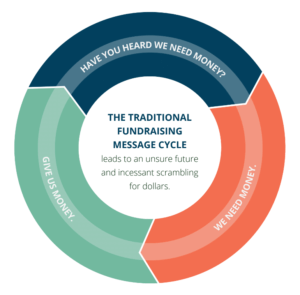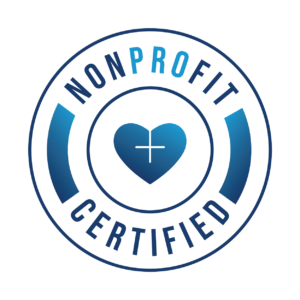
Do Fundraising Professionals Really Sell?
July 9, 2021
Breaking Down the Confusion: What is Cybersecurity really?
July 16, 2021Fundamentals of Audience Growth in the Nonprofit Sector

How can your nonprofit organization increase its audience growth? You have a cause and a message to share, but getting it out there to the right people isn’t always easy. To help organizations grow their audience—and also their returns and impact—I created an approach to communication development based on a system I’ve labeled IDEAS.
Here’s what the IDEAS process looks like.
When maximizing audience growth, an aimless attempt rarely works. Your organization needs a specific and actionable plan, and that’s where IDEAS comes into play. The process flows like this:
- Insights | This is the beginning of the process. In this phase, we start by questioning and seeing what gives us pivotal knowledge. This helps provide the basis for confident action.
- Direction | Here is where you narrow down what insights you learned and what actions you need to take. During this phase, it’s important to spend time determining and designing solutions for specific goals.
- Expression | Now it’s time to explore and develop messaging (both verbal and visual) for a stronger brand. The goal is to create compelling communications that move audiences to your brand. You want this to be done in a way that’s meaningful and generates interest and support.
- Action | Here is where we generate a “go-to market” approach. Through a strategy and careful planning, this approach should positively impact every key audience you want to reach. Make sure to keep those brand touch points in mind.
- Success | In this phase, we evaluate. It’s critical to look for ways to measure and optimize your organization’s investment and leverage progress. Look for ways to yield better outcomes and create unstoppable momentum.
What makes this IDEA different?
I have found through several decades of using the IDEAS process that this approach to audience growth is strategic and effective. This method provides customized solutions to common organizational marketing issues. Plus, it allows for new opportunities for growth.
Unlike the processes of many agencies and consultants that serve the nonprofit community, the IDEAS process is not about “boiler-plate” or “off-the-shelf” solutions. While the firms that do offer these types of services have very predictable outcomes, they also have a very predictable pattern of locking nonprofit organizations into never-ending programs. These tend to have diminishing returns, cause donor fatigue, and have dismal relationship retention rates. That’s the opposite of good growth.
IDEAS drive success.
The IDEAS process takes its approach from the pages of what many of the world’s biggest and most prolific brands do to grow their organizations.
Ultimately, it helps your organization create a unique position in the minds and hearts of key support audiences. Over time, these audiences will yield significantly better outcomes and help to create more meaningful brand relationships. Before you know it, you’ll see success as a ripple effect that extends and grows your organization for years.
But how can you ensure your organization is doing this well? Positioning and differentiation are key to the IDEAS process. These are the two primary filters that every step in the process needs to measured against—i.e., how does this give us a strategic advantage, and how does this separate our offering from competitive offerings? Many experts have written books on positioning and differentiation, but most of the principles can be boiled down to three strategies:
- Build on your strengths. What is your organization really good at (better than your competitors)? Examples: Holistic care? Program completion success? Saving lives?
- Zero in on a niche. What are one or two things you do exceptionally well? Examples: Speedy care? Quality staff? Tending to the needs of specific people groups or neglected areas?
- Reframe the competitive alternative. What do you offer or provide that your competitors don’t? Examples: Higher tech? Higher touch? Easier access? Lower cost? Greater efficiency?
Using positioning and differentiation in your approach helps drive the best IDEAS.
Persuade with reason and motivate with emotion using IDEAS.
Another key concept that makes IDEAS work is understanding logic. While we need logical reasons for making decisions, logic alone will not motivate people to take action. It is also unlikely to change behavior. Instead, we must feel that taking action or changing a pattern of behavior will lead to satisfaction on a personal level.
That’s where emotion comes in. From the time of ancient Greek philosophers, we’ve understood the importance of both heart and mind decision-making. The latest research underscores this. An emotional connection is absolutely crucial for organizations to succeed in today’s competitive marketplace. If you can use IDEAS to motivate your audience with emotion, you’re on the right track!
Overall, the most effective marketing and branding efforts target emotions tied to personal values. Self-esteem, security, peace of mind and enjoyment are all common motivators tapped by for-profit marketers. Nonprofits, on the other hand, typically need to connect with personal values that are outside of one’s self image. This includes values like care for others, concern for future generations, preservation of resources, and making a difference.
Using the IDEAS method, you can maximize your audience growth and make a bigger impact for your organization.
To learn more about growing your audience, grow your knowledge by earning your Nonprofit Foundations Certificate. Session three is led by nonprofit communications thought leader Bill McKendry, founder of DO MORE GOOD®. Note: the Nonprofit Foundations Certificate program is tailored for Christian ministries.
The post Fundamentals of Audience Growth in the Nonprofit Sector appeared first on Nonprofit Hub.
